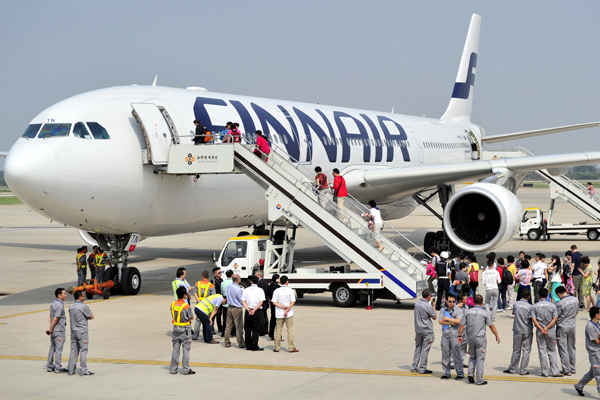Foreign carriers compete in 2nd-tier cities
Updated: 2013-08-03 02:54
By Wang Wen (China Daily)
|
|||||||||||
Foreign airlines are competing fiercely for business in second-tier cities in West China, despite the lower profitability of the routes in the region.
British Airways Plc, which hasn't launched new routes in the country in seven years, will open a London-Chengdu route in September.
 |
|
The first flight of Finnair Plc's Helsinki-Xi'an route arrived in Xi'an, capital of Shaanxi province, on June 15. YUan jingzhi / for China Daily |
"We recognize that China is not just metropolises such as Beijing and Shanghai, and that other cities are also developing," said Willie Walsh, chief executive officer of IAG, BA's parent company.
On June 15, the first flight of Finnair Plc's Helsinki-Xi'an route arrived in Xi'an. The route is also the first non-stop one from the capital of Shaanxi province to a European city.
Finnair operates its Xi'an service three times a week, with Airbus 330 and 340 aircraft used on the nine-hour route.
The city of Xi'an is Finnair's fifth destination in China. The carrier has been running four flights a week between Helsinki and Chongqing — another western city in China — for a year.
"We know the western part is currently growing very fast and the economic potential in the region is great," said Pekka Vauramo, CEO of Finnair.
He said the government's go-west policy has encouraged the carrier to grab the booming business opportunities in the area.
However, industry insiders wonder if the passenger flow in western cities will be able to provide profits for airlines.
Xi'an only ranked 18th on a list of Chinese cities welcoming inbound tourists in 2011, according to the local government.
The low inbound-tourism figures resulted from a lack of business travelers, said Kang Lifeng, deputy director of the Xi'an tourism administration.
Vauramo refused to comment on the profitability of the new routes to western China, but he said the Chongqing-Helsinki route still "has room to grow".
Carriers have to invest significantly before the routes in western cities become profitable, although that will be possible over time, he said.
"There's some hard work in the beginning and some investment needed for quite a long time," he added.
Meanwhile, in order to occupy positions before the market booms, foreign airlines are taking action to run new international routes to the western cities.
Air France-KLM Group has run its Chengdu-Amsterdam route since 2006, while in late 2011, Etihad Airways introduced a Chengdu-Abu Dhabi route.
Many second-tier cities in China have bigger populations than some big cities in Europe, business insiders said, and the Chinese people's increasing passion for outbound tourism has given foreign airlines more confidence to invest in the market.
On the other hand, local governments are making efforts to encourage airlines to operate international routes to stimulate local economic development.
The local governments' subsidies are an important support for the carriers to run the new routes, some business insiders said.
Busy airports in Chinese big-hub cities also pushed the airlines to smaller cities.
"Airports in large cities are too busy to launch new routes," the IAG's Walsh said.
Airports in second-tier cities have more airspace and slots and they charge less than big-city airports, said Li Xiaojin, a professor at the Civil Aviation University of China in Tianjin.
"Foreign airlines can save if they operate routes between their hubs and smaller Chinese cities," Li said.
The competition in the second-tier cities is not as stiff as in the major hubs, he added.
Today's Top News
China, US hold dialogue on human right
Berlusconi loses final appeal in landmark case
FM urges restraint on sea issues
Foreign carriers compete in 2nd-tier cities
Top jobs getting difficult to fill
Investment promotion between China and Ontario
Farmers see hope of city life in hukou reform
Singer's bomb threat sparks debate
Hot Topics
Lunar probe , China growth forecasts, Emission rules get tougher, China seen through 'colored lens', International board,
Editor's Picks

|

|

|

|

|

|





